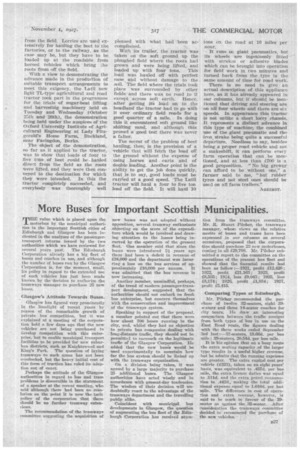More Buses for Important Scottish Municipalities.
Page 45

If you've noticed an error in this article please click here to report it so we can fix it.
THE value which is placed upon the motorbus' by the municipal authorities in the important Scottiah cities of Edinburgh and Glasgow has been indicated in the analyses of the passengertransport returns issued by the two authorities which we have reviewed for several years past. The Edinburgh Corporation already has a big fleet of buses and coaches in use, and although the number of buses rim by the Glasgow Corporation is, for the moment, small, its policy in regard to the extended use of such vehicles has just been made known by the decision to authorize the tramways manager to purchase 25 new buses.
Glasgow's Attitude Towards Buses.
Glasgow has figured very prominently in the limelight of recent years by reason of the remarkable growth of private bus competition, but it was explained at a meeting of the corporation held a few -days ago that the new vehicles are not being purchased to develop competition with this enterprise, but to enable municipal transport facilities to be provided for new suburban districts, such as Knig-htswood and King's Park. The question of laying tramways to such areas has not been overlooked, but the heavy initial cost of this form of traction has ruled its adoption out of court.
Perhaps the attitude of the Glasgow authorities in regard to bus and train problems is discernible in the statement of a speaker at the recent 'meeting, xvho said although -there had been no resolution on the point it is now the tacit policy of the corporation that there slicedd be no further tramway extensions.
The recommendation of the tramways committee saggesting the acquisition of new buses was not adopted without opposition, several tramway enthusiasts ,objecting on the score of the expendi fore Which would be involved and drawing attention to the losses being in curred by the operation of the present fleet. One member said that since the hues were introduced 2i years ago there had been a •-deficit in revenue of £24,000 and the department was incurring a loss on the bus services of ap proiimately £10,000 per annum. It was admitted that the bus revenue is now increasing.
Another member, unmindful, perhaps, of the trend of modern passenger-trans port -development, suggested that the authorities shordd not embark nn fresh
bus enterpriae, but concern themselves with the conservation and improvement of the tramways system.
Speaking in support of the proposal, a member panted out that there were now about 700 buses running in the City, and, whilst they had no objection to private bus companies dealing with long-distance traffic, they should not be permitted to encroach on the legitimate traffic of the Glasgow Corporation. Ile added that the new buses would be rued experimentally to ascertain how for the burs system should be linked up with the tramways organization.
On a division being taken, it was agreed by a large majority to purchase 25 additional 'buses. The Glasgow
authorities have acted wisely -and in accordance with present-day tendencies.
The wisdom of their decision will undoubtedly react to the advantage of the tramways departmeat and the travelling public alike.
Coincident with mimiei pal bus developments in Glasgow, the question of augmenting, the bus fleet of the Edinburgh Corporation has received aften tion from the tramways committee. Mr. It. Stuart Pileher, the tramways manager, who views on the relative merits Of buses and trams have been expressed in our columns on several occasions, proposed that the corporation should purchase 23 new motorbuses., costing in all £29,708. Mr. Pilcher submitted a report to the committee on the operations of the present bus fleet and showed that the financial results had been as follow :-1921, profit £12.429 ; 1922, profit £21.163; 1923, profit -18,505; 1924, loss £9,043; 1925, less £8,174; 1926, profit £1,934; 1927, profit £5,415.
Comparing Types at Edinburgh.
Mr. Pilcher recommended the purchase -of twelve 32-seaters, eight 39seaters and three 14-seater coaches for city tours. lie .drew an interesting comparison between the traffic receipts from both types of bus in use on the East Road route, the figures dealing with the three weeks ended September 3rd last---32-seaters, 18.66d. per bus mile; 39-seaters. 20.54d. per bus mile.
It is This opinion that on a busy route the extra seating capacity of the larger type results in a useful higher revenue, but be admits that the running expenses are greater. The extra capital cost per vehicle (£323), taken on an eight years' basis, was equivalent to .457d. per bus mile, the extra licence duties was equal to Mid. and the extra petrol consumotion to .442d.; making the total additional expense equal to 1..010d. per bus mile. The difference in cost of operation and extra revenue, boweVer, is said to be much in favour of the 39seater as against the 32-seater. After consideration the tramways committee decided. to recommend the purchase of the -new vehicles.




































































































